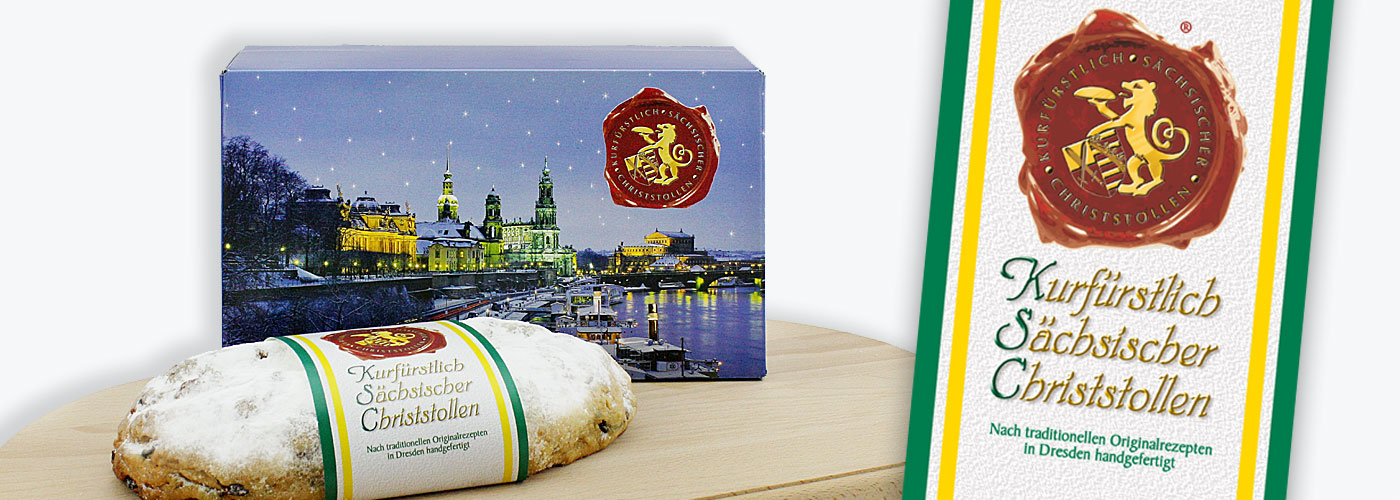
Kurfürstlich Sächsischer Christstollen® – our house brand – made according to an old family recipe
Kurfürstlich Sächsischer Christstollen® is a raisin stollen whose recipe is closely based on the original Dresdner Christstollen®. For over 40 years and now in the fourth generation, our Christstollen – including Kurfürstlich Sächsischer Christstollen® – have been baked by hand in a Dresden bakery that is highly regarded as a craft and family business in Dresden.
Through consistent quality, this master company has earned the long-standing trust of its clientele, as well as numerous awards. For 18 years now, we have been organizing the worldwide shipment of Christmas stollen for this bakery and are pleased that Kurfürstlich Sächsischer Christstollen® has also found its lovers beyond Saxony’s borders.
Electoral Saxon history
The Electorate of Saxony was a territory of the Holy Roman Empire, created in 1356 by the elevation of the Duchy of Saxony-Wittenberg to an electorate by Emperor Charles IV in the Golden Bull.
When Albrecht II died in 1296, his son Rudolf I succeeded him in the government. In the dispute between Louis the Bavarian and Charles of Luxembourg over the German kingship, Rudolf I sided with Charles, for which he was permanently rewarded with the electoral dignity in 1356. Saxony-Wittenberg had thus finally risen to become one of the seven German electorates.
In 1470, Elector Ernst of Saxony and his brother Albrecht approached Pope Innocent VIII with a request to lift the ban on butter, since church dogma forbade the use of butter and milk for baking stollen. The Holy Father wrote the so-called “Butter Letter”, which allowed to use also butter, milk and fine ingredients such as raisins, almonds and fruits for stollen upon payment of a penance.
Frederick August I of Saxony, often called August the Strong (b. May 12, 1670 in Dresden; † February 1, 1733 in Warsaw), was an elector of Saxony descended from the Albertine line of the Wettin princely dynasty. Due to the Polish royal dignity August the Strong is often mistakenly called King of Saxony.
In 1730, Augustus the Strong, Elector of Saxony and King of Poland, surpassed all previous tunnel weights with his order for a huge tunnel on the occasion of the Zeithainer Lustlager.
The “Zeithainer Lustlager” was an organizational masterstroke that caused a sensation throughout Europe. It was not only the largest show of troops in Europe, it was above all considered the most gigantic baroque festival of its time, the “spectacle of the century”, which because of its splendor and opulence is still the epitome of baroque lifestyle.
So he had the bakers’ guild of Dresden bake a giant stollen by master baker Zacharias and sixty bakers’ servants. It weighed 1.8 tons, was 18 cubits long (about 7 meters), 8 cubits (about 3 meters) wide and 30 centimeters thick. It had been baked in an oven specially built for the purpose by Matthäus Daniel Pöppelmann and brought to August’s camp from the Mühlberg bakehouse on a wagon drawn by eight horses. There, the baked goods were cut with the famous “Big Stollen Knife”, divided into 24,000 portions and handed out to the guests.
This event is linked to the annual Stollen Festival held in Dresden on the eve of the 2nd Advent. Since the nineties, the Stollen Festival has been part of the program of the Dresden Striezelmarkt and is immediately its highlight.
-
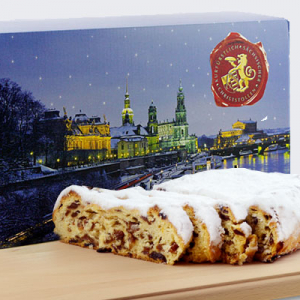
Kurfürstlich Sächsischer Christstollen® 500 g in gift box
11,15 €(22,30 € / kg)
incl. 7% VAT
plus shipping costs
Ausverkauft
Product contains: 0,5 kg
-

Kurfüstlich Sächsischer Christstollen® 1000g in gift box
19,30 €(19,30 € / kg)
incl. 7% VAT
plus shipping costs
Ausverkauft
Product contains: 1,0 kg
-
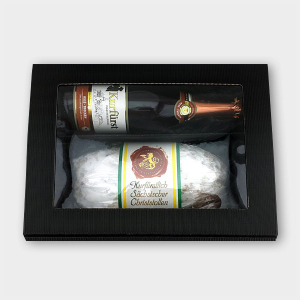
Kurfürstlich Sächsischer Christstollen® 1000g and Kurfürst sparkling wine rosé
32,20 €incl. 7% VAT
plus shipping costs
Ausverkauft
-
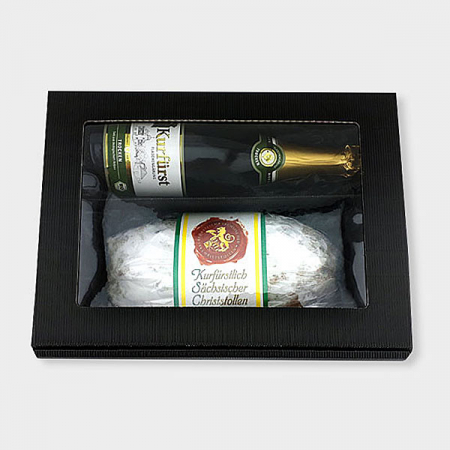
Kurfürstlich Sächsischer Christstollen® 1000g and Kurfürst sparkling wine dry (white)
32,20 €incl. 7% VAT
plus shipping costs
Ausverkauft
-
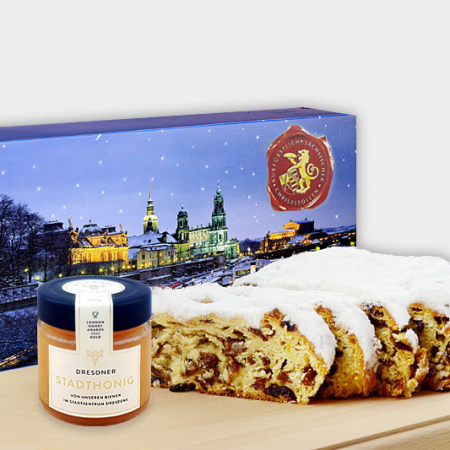
Kurfuerstlich Saxon Christstollen® 1000 g and Dresden city honey 150 g
25,30 €incl. 7% VAT
plus shipping costs
Ausverkauft
-
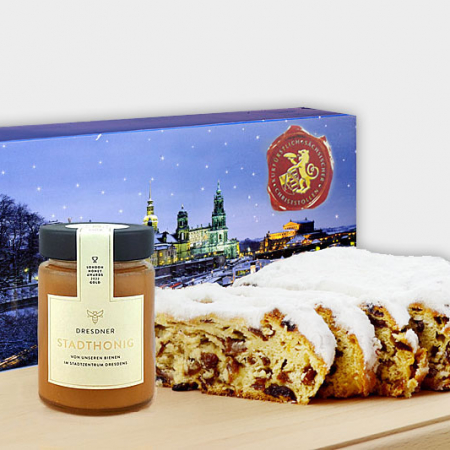
Kurfuerstlich Saxon Christstollen® 1000g and Dresden city honey 250 g
29,30 €incl. 7% VAT
plus shipping costs
Ausverkauft
-
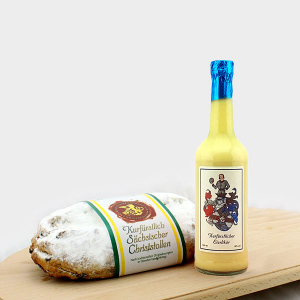
Kurfürstlich Sächsischer Christstollen ® 750 g and Kurfürstlicher Egg Liqueur 500 ml
31,10 €incl. 7% VAT
plus shipping costs
Ausverkauft
-
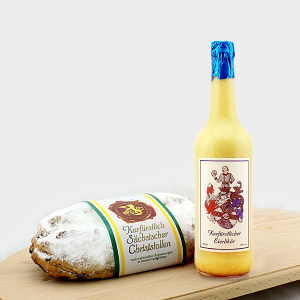
Kurfürstlich Sächsischer Christstollen ® 1000 g and Kurfürstlicher Egg Liqueur 700 ml
37,30 €incl. 7% VAT
plus shipping costs
Ausverkauft
This post is also available in: German




